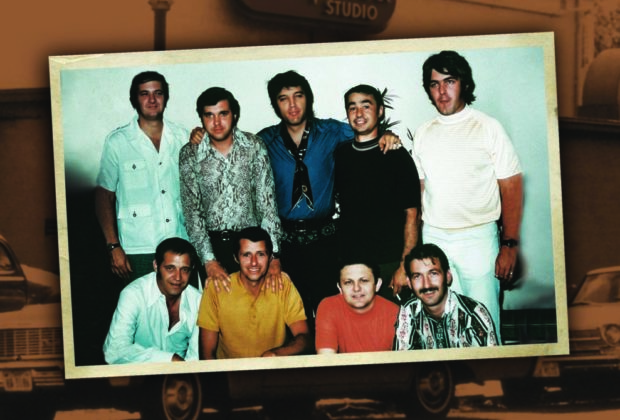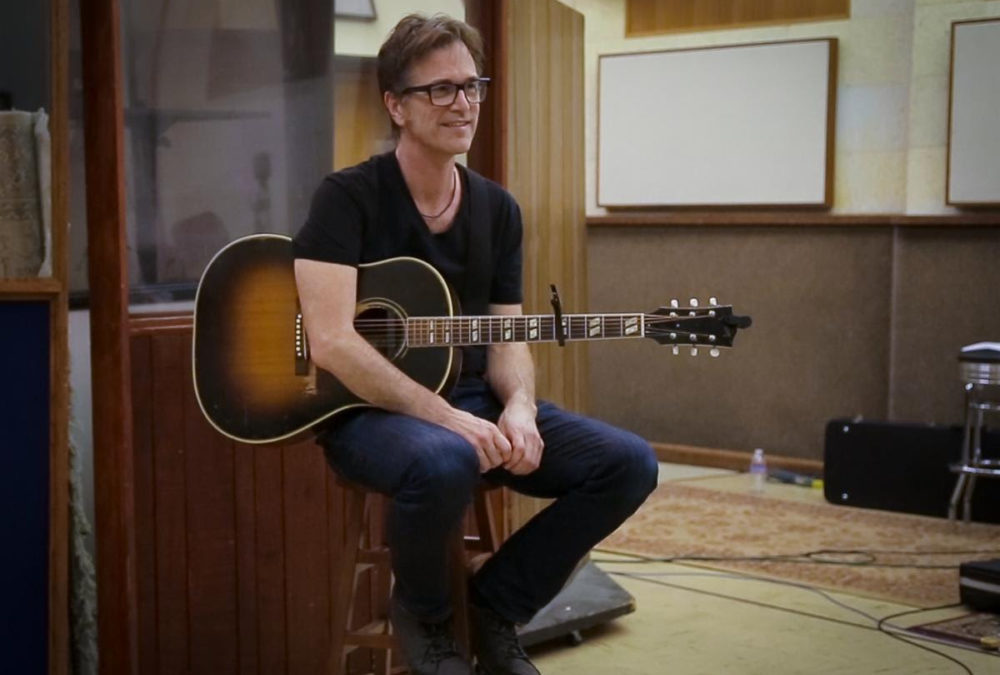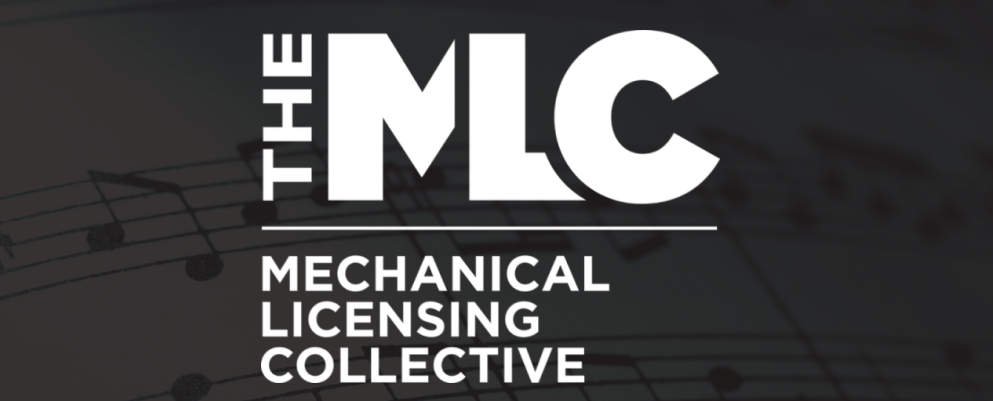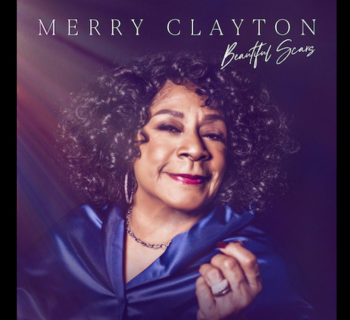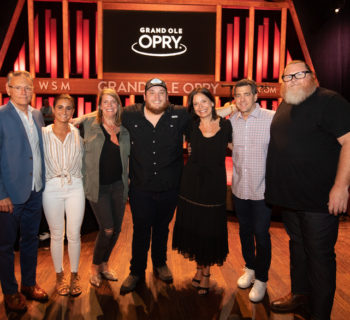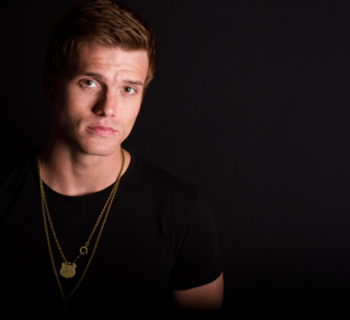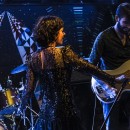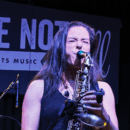Elvis Aron Presley was born January 8, 1935 in Tupelo, Mississippi. He left the physical world on August 16, 1977 from Memphis, Tennessee.
Sony Music during December 2020 released Presley‘s 1970 sessions in Nashville, Tennessee in a new four-CD set, From Elvis in Nashville.
Presley’s first recordings of the 1970s saw him cut loose live in the studio with a band in sync with his sensibility. Recorded live in RCA’s Studio B in Nashville over the course of a five day/night run in June (there was also an additional session on 22 September), Elvis’ performances from those sessions formed the core of the albums Elvis: That’s the Way It Is, Elvis Country (I’m 10,000 Years Old) and Love Letters from Elvis.
The master recordings are presented together for the first time on the first two discs of the four-CD set and are newly mixed by engineer Matt Ross-Spring without the added overdubs or orchestration appearing on previous releases. Additionally this set includes two discs of rare/unreleased outtakes, such as “Funny How Times Slips Away,” “Bridge Over Troubled Water,” “I’ve Lost You” and more.
At the close of the 1960s, Elvis Presley, the atomic-powered singer of the 1950s, put his stamp on the rock revolution decade, reestablishing himself as a musical and cultural force to be reckoned with.
His electrifying Elvis '68 Comeback Special made television history and Presley’s long-awaited return to non-soundtrack recordings- captured at Chip Moman's American Sound Studio in Memphis, January-February 1969- yielded wonderful major chart hits including “In The Ghetto,” “Don't Cry Daddy,” “Kentucky Rain,” and “Suspicious Minds,” which was Elvis' final #1 single.
The dates also yielded a pair of acclaimed 1969 album releases, From Elvis In Memphis and the studio/concert hybrid From Memphis to Vegas/From Vegas to Memphis. From Elvis In Nashville serves as a mirror and companion to his earlier Memphis recordings, bringing fresh fire, exuberance, humor and emotional resonance to the Studio B sessions.
If the American Sound recordings in Memphis opened the door for Elvis' return to the stage and top of the charts, his next recordings- the fabled 1970 Marathon Sessions- would lay the groundwork for another revolution in pop music. Under the direction of producer Felton Jarvis, Elvis joined forces with one of the most potent studio ensembles ever assembled to create an often underrated chapter in Presley's rich legacy.
Working with the fabled “Nashville Cats” for his first album of 1970, Elvis Presley connected to a circle of contemporary musicians that included Johnny Cash, Bob Dylan, Neil Young, George Harrison and others.
In June 1970, Elvis- who'd upended country music radio in the 1950s when he introduced rock 'n' roll music to the mainstream--returned to RCA Studio B to create a new sound for a new decade. From 1958-1971, Elvis recorded more than 200 tracks at Studio B, beginning with five songs- including “A Fool Such As I” - before shipping off to Germany with the US Army in September 1958; he recorded Elvis Is Back!, his first post-army album, at Studio B in March-April 1960.
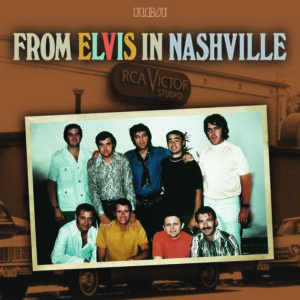
Courtesy of Sony Music
A winter 2020 announcement from Sony Music further described the Elvis In Nashville retail product.
“For his 1970 Nashville sessions, Elvis was able to handpick his own repertoire and, delve into the rich variety of American music in his marrow, combining elements of bluegrass, honky tonk, Western swing and the rockabilly he'd virtually invented with contemporary pop, ballads and epic showstoppers. Bringing a fresh and vital new approach to pop and country music, Elvis' performances on From Elvis In Nashville presaged and encompassed emerging trends from countrypolitan and Americana to outlaw country.
“These sessions are widely recognized as among Elvis' best because of the undeniable chemistry between Elvis and his astonishing studio band comprised of multi-instrumentalist Charlie McCoy (whose resume includes Bob Dylan's Highway 61 Revisited, Blonde On Blonde, John Wesley Harding and Nashville Skyline as well as work with Paul Simon, Tanya Tucker, Bob Seger, Willie Nelson and many more); bassist Norbert Putnam (Roy Orbison, Al Hirt, Henry Mancini, Dan Fogelberg, Linda Ronstadt, J. J. Cale, Tony Joe White, more); and pianist David Briggs (who's worked with Dean Martin, Joan Baez, Nancy Sinatra, B.B. King, Johnny Cash, Dolly Parton, Waylon Jennings, Tony Joe White, George Harrison, Todd Rundgren, Roy Orbison, the Monkees, J. J. Cale, Kris Kristofferson, Alice Cooper, among others).
“Known colloquially as the 'Nashville Cats', this finely-honed studio ensemble, like Elvis himself, connected the worlds of pop, rock and country music. For the June sessions, Elvis brought in his longtime on-stage guitarist James Burton; Eddie Hinton- who, like Putnam ad Briggs, was part of the Muscle Shoals Rhythm Section- played lead guitar on Elvis' September 22 session. Elvis plays acoustic guitar throughout the June sessions.
“The music Elvis created in his 1970 'marathon sessions' - presented here without layers of overdubbing heard on the original releases- stands among Presley's best and has proven immensely influential. It established musical directions he pursued the rest of his career, predicted his late-in-life pop- and-country radio successes, and modeled sounds for countless country stars to come. From Elvis In Nashville provides an intimate glimpse into the world of Elvis and the way he made music that lasts forever.”
Over the decades I’ve interviewed musicians who recorded with Elvis Presley: Scotty Moore, Glen D. Hardin and James Burton.
Former RCA publicist Grelun Landon, who headed Public Affairs for the label in Hollywood arranged for me to attend a slew of Elvis 1971-1976 concerts and meet Presley’s manager, Colonel Tom Parker. Landon also invited me to tour the RCA recording facilities with Presley entourage members and RCA executives. Elvis had recently been in one RCA studio room cutting vocals. Man, just hearing the magnificent voice of Elvis Presley isolated on those big Altec 604E Super Duplex speakers while being inside the environs of RCA, where Andrew Loog Oldham produced the 1964-1967 recording sessions of the Rolling Stones.
I saw Elvis once in Dr. Morris Feldman’s Picwood Dental Office in West Los Angeles nearby the M-G-M studio in Culver City on a Saturday afternoon during the summer of 1967.
Presley arrived in a Rolls Royce, flanked by two guys, walked into the waiting room and gave a smile. When it was my turn for the chair, Dr. Feldman told me Elvis broke a tooth during the filming of a movie called Speedway.
The 50th anniversary of Elvis Presley's groundbreaking 1968 NBC-TV "comeback" was commemorated a couple of years with the release of a deluxe box set by RCA/Legacy Recordings, a division of Sony Music Entertainment.
I had penned the 5,000 word liner note booklet for their 40th edition the label issued in 2008. In 2007 I was interviewed for M-G-M Home Entertainment DVD deluxe version of Presley’s feature film Viva Las Vegas.
In my 2020 book Docs That Rock, Music That Matters, I examined the Bones Howe-engineered and the Steve Binder-directed The '68 Comeback Special (at the time titled Singer Presents…ELVIS) which originally aired on December 3, 1968 and was a pivotal broadcast event that upped-the-ante on Elvis' career, the evolution of pop culture and the history of television.
“By 1968, prior to the broadcast, Elvis was no longer seen by the mainstream as the atomic-powered rock and roll pioneer. Since his discharge from the United States Army in 1960, Elvis' career path careened through a string of low-budget (though often successful) formulaic films while the rock music scene was exploding with innovation, experimentation, and an urgency to complement the turbulent era. Elvis hadn't performed in public since 1961 and hadn't appeared on television since 1960.
“The special, recorded over several sessions in June 1968, presented Elvis in a variety of settings, from spectacular production numbers ("Nothingville," "Saved," "Guitar Man," "Little Egypt," "Big Boss Man," "Let Yourself Go") to the intimate "sit-down" performances of classic Elvis hits, reuniting the artist with Scotty Moore and DJ Fontana, the guitarist and drummer who'd played alongside Elvis on his earliest records and shows.
“The black leather "sit-down" and "stand-up" sequences provided a retrospective of Elvis' career to that point, highlighted with the new song "Memories," written by Mac Davis specifically for the show. The special's transcendent closing number was Presley's now-classic, emotionally fueled performance of "If I Can Dream," an anthemic new song penned especially for Elvis and the special by W. Earl Brown.”
The special was the most-viewed television program in America the week it aired and firmly reestablished Elvis as a major musical and cultural force.
The success of the '68 Special reignited Presley's career in a major way. Shortly after the special aired, Elvis entered American Sound Studio in Memphis for the sessions that generated "Suspicious Minds," one of his most enduring #1 hits and his country-soul masterpiece From Elvis In Memphis (which included the chart-topping "In The Ghetto"). 1969 saw Elvis return to live performance with a record-breaking engagement at The International Hotel in Las Vegas, kick starting a regular run of live shows that lasted for the rest of his career.”
According to Binder, "The only time in network history, I think, that in prime time a variety special for a star like Elvis had no guest stars. He was the star, period."
After my family saw the ‘68 Comeback Special, my folks went to see one of Presley’s August 1969 shows at the International Hotel in Las Vegas and gave an enthusiastic review.
On November 14, 1970 I took three buses from West Hollywood to Inglewood to see Elvis Presley’s debut at the Forum, his first concert in Southern California in 13 years. In 1968 I saw the Doors at the Forum, the Rolling Stones twice in 1969 at the same venue and now Elvis.
It was a devoted beehive hairdo crowd like a casting call from another era. Thousands of cameras clicked and flashed when Elvis emerged on stage. Presley’s vocals sounded terrific as I sat in the Colonnade section.
Returning home later that evening, I discussed the one-hour Presley show with then GO! magazine reporter Rodney Bingenheimer at the Hollywood Ranch Market on Vine St. over hot tater tots.
“I worshiped The Elvis The ’68 Comeback Special and he was back on the pop charts again,” Bingenheimer proclaimed. “And, unlike a lot of people at the time, deejays, music reviewers, I never left the Elvis fan club. Around 1969 I went to the Presley band rehearsal with a local guy we called President Randy. It was at a rehearsal on Vine St. and Fountain Ave. It was amazing watching Elvis rehearse. There were only a few people in the room. Elvis autographed the Elvis and Colonel Parker calendar for me.
“During 1969 when I was writing a column for GO! magazine. I went to the Elvis press conference in Las Vegas when he was making his debut at the International Hotel. I know he played Las Vegas in the fifties on a bill with Liberace, but this was Elvis’ return to performing after eight years. Grelun Landon, who was the head PR guy at RCA in Hollywood, took care of me. Nick Naff the PR guy from the Las Vegas International wanted me to cover the opening night as well.
“As a fan and reporter, I had a weekly music column in a national paper distributed in record stores, as FM radio was only a year or two old at the time. Over the years I was at many Elvis’ openings and closings. After the first show in August 1969, and around a couple of parties, Colonel Parker told me that Elvis saw GO! and said, ‘Get me a subscription to GO!’
“Elvis introduced me to Frank Sinatra at at Nancy Sinatra’s party. Elvis was closing his engagement in Las Vegas and Nancy was opening the next night. Frank walks in the room while I’m talking to Elvis. ‘Frank. This is Rodney.’ I took a photo with Elvis and it ran in GO! Magazine,” he proudly attests.
Rodney was a friend of singer/songwriter Del Shannon who Elvis personally invited to one of the performances and during his residency Presley sang Del’s “Runaway” nightly.
In summer 1970 Presley returned to Las Vegas for his headline engagement at the Hilton Hotel. “Memories” was included in the opening night set list. He was backed by his core band and the Sweet Inspirations under the direction of musical director Joe Guercio and his Orchestra. By October, Presley was back at the #1 position on the hit parade with the Mark James-penned cautionary tale “Suspicious Minds.
50 years later I asked several friends in December 2020 to reflect on Presley’s film career and his string of Ed Sullivan Show television appearances.

Courtesy of SOFA Entertainment
Andrew Solt Filmmaker: We have to understand that booking Elvis Presley was in a way a ratings decision. Ed had stated earlier that he would NEVER allow Presley to appear on his program – he said that he didn't feel Elvis was right for his show. However, he then witnessed reactions and ratings from of some of Elvis' other television appearances.
“Before he went on The Ed Sullivan Show, Elvis had already been on other programs like Steve Allen, Milton Berle and The Dorsey Brothers ... so Ed was NOT the first television host to bring Elvis Presley into America’s living rooms ... yet it seems to be The Ed Sullivan Show appearances are often what people remember most. History was made on Sullivan and his audience was by far the biggest. So Ed finally gave in ... Ed knew that by booking him on his program, Elvis would deliver huge ratings ... so he agreed to pay Colonel Parker's then unheard of, outrageous fee of $50,000 for three performances. And, exactly as expected, Elvis delivered 60+ million viewers on September 9, 1956 – his first Sullivan show. I'm sure Ed and CBS considered it money well spent at the time.
“Ed genuinely liked Elvis. Even when the network censors decided that Elvis could only be filmed from the waist up on his last Sullivan appearance, Ed made it a point of coming over afterwards and thanking Elvis, telling the audience and the world that he had never had a more pleasant experience than working with this fine, fine young gentleman. He called Presley ‘a real decent, fine boy’ and because of his credibility with the public, parents relaxed their views about Elvis and were less inclined to say he was a bad influence, kind of a juvenile delinquent leading their children down the destructive path of sex, drugs and rock and roll.”
Andrew Loog Oldham Record Producer/Author: Elvis Presley on film. King Creole directed by Michael Curtiz, based on the Harold Robbins' novel. Always. New Orleans. Singing 'Craw Fish.' The balcony. The black slacks and Carolyn Jones. Other fave is his poolside rendition of 'Baby, I Don't Care' in Jailhouse Rock. The cable knit roll up sweater. The black slacks and black hair and who can forget Judy Tyler.
“The other moment. Elvis, after having been slugged in the neck by valet Mickey Shaughnessy, walks to piano with dressing gown AND cravat and sings 'Young and Beautiful.' And it's Mike Stoller at the piano."
Daniel Weizmann Writer: In THE MOVIE MUSICAL (St. Martin's, 1981) brilliant Broadway critic Ethan Mordden defended Elvis musicals. "To dismiss Presley,” he wrote, “is New York solipsism." But Mordden was hip that Elvis had a cinematic struggle on his hands.
“Reconciling his actual rock and roll self with the tropes of story musical form was near-impossible. For my money, Viva Las Vegas is the best Elvis flick because it never pretends that it can escape being an MGM spectacular.
“The original trailer hollers that it's the ‘swingin'est singin'est grooviest lovin'est Entertainment Sensation it has ever been your luck to enjoy’--how's that for All-American confidence? But Elvis as devil-may-care mechanic and Grand Prix racer Lucky Jackson up against female hot rod Rusty Martin (played by you-know-who) is pure entertainment: high speed races match big dance numbers in luxury settings (choreographed by David Winters of the original West Side Story cast), and the quasi-innocent sexuality and youthful exuberance are off the charts.
“Most of all: Before Ann Margaret, Elvis never had a screen partner with anything near the sexual force to match his. When she hits the screen, she brings him down to almost-human-sized so that the story can function and do its thing. For once, his mythic Elvisness doesn't get in the way--almost.
“Viva Las Vegas debuted in the spring of '64, three years before my family moved to America. When I watch it today, the immigrant kid in me wonders how a flick like this must have appeared to foreign eyes. The faraway Land of Plenty has never been this plenty--affluence pours off the screen on every level, right down to affluence of spirit. It's a gas.”
Gary Pig Gold Writer/Musician: Elvis and the 50th State long enjoyed a close relationship – 1961's USS Arizona benefit concert then box-office-busting Blue Hawaii, not to mention Paradise, Hawaiian Style five years later (actually, perhaps we shouldn't mention that one) – and the islands had frequently been a favored vacation spot for The King and his courtiers," reminds reluctant haole Gary Pig Gold.
"It seems only fitting then that what turned out to be Elvis' final, and perhaps biggest of all bangs beamed clear 'cross the universe out of the Honolulu International Convention Center Arena minutes after midnight on January 14, 1973. Twenty-three songs in just under 80 minutes with 6,000-plus in attendance, $75,000 raised for the Kui Lee Cancer Fund, $2.5 million in production costs, over a quarter-million double QuadraDisc™ soundtrack albums moved within ten days ...and, most Earth-shattering – literally! – of all at the time? A satellite viewing audience 'in excess of one billion people.' At least according to the Colonel.
"Whatever these numbers may truly be, the performance itself was truly extraordinary; the TCB Band by this point having spent countless Instamatic flashcube-illuminated hours on stage honing their sets to a flawless peak-and-valley-then-peak-again running order. And to demonstrate just how seriously Elvis himself took this event can be judged via his even more punishing than usual pre-Aloha fitness regimen: Drastically increased daily karate workouts under the supervision of Master Kang Rhee helped along with, according to those nearby, megavitamin vials, large quantities of protein drink, weighted racquetball workouts, diet pills by the handful, mineral water by the gallon and a daily injection understood to include the urine of a pregnant woman.
“Nevertheless, come show time Elvis had 'dropped down to 165 pounds; thin as a rake and more handsome than ten movie stars' in the wise guy words of Memphis Mafioso Sonny West. All the better then to fill Bill Belew's custom 'white American Eagle' jumpsuit ...the $10,000 cape from which Elvis sailed clear into the audience at the conclusion of 'Can't Help Falling In Love.'"
I’ve always enjoyed listening to Elvis Presley’s Aloha from Hawaii Via Satellite which was a concert broadcast that he headlined, and an international live event via satellite on January 14, 1973.
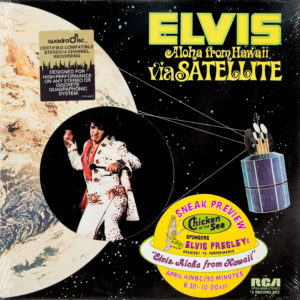
Courtesy of Sony Music
The show took place at the Honolulu International Center in Honolulu and aired in over 40 countries across Asia and Europe. Presley made history as the first solo entertainer to do a live concert beamed internationally.
In March, 2013, RCA Legacy Recordings, a division of Sony Music Entertainment released Aloha From Hawaii Via Satellite: Legacy Edition, a re-mastered edition soundtrack from world's first full-length concert satellite broadcast of January 1973.
A second CD is also included, a remixed and re-mastered rehearsal show edition of the early “dress rehearsal” show. In addition, this Presley retail configuration now has 5 bonus songs recorded at 3:00 a.m. in behind-closed doors session.
The 40th anniversary of the historic one-hour satellite broadcast of Elvis Presley from the Honolulu International Center Arena in January 1973, viewed by over 1.5 billion people worldwide, is now documented with this double CD, another pivotal moment in a storied life.
Aloha From Hawaii Via Satellite: Legacy Edition marks the first time that both shows performed by Elvis, as released separately in 1973 (the original double-LP Aloha From Hawaii via Satellite) and 1988 (the CD The Alternate Aloha), have been coupled together in one package. At the same time, the show that The Alternate Aloha was based on has been completely remixed from the original multi-track tapes.
The repertoire on this 2013 Aloha configuration contains “See See Rider,” “Burning Love,” a rendition of George Harrison’s “Something,” a stellar reading of “You Gave Me A Mountain” made famous by Marty Robbins, a couple of Jerry Leiber and Mike Stoller tunes, “Love Me” and “Hound Dog,” “Blue Suede Shoes” and “I’m So Lonesome I Could Cry,” display Elvis in top vocal form. Also revealing are his live takes on “Fever,” “What Now My Love,” “Suspicious Minds” and “I’ll Remember You.”
The musicians backing Presley in his Hawaiian performances are: Guitar: James Burton; Guitar: John Wilkinson; Guitar & Vocals: Charlie Hodge; Bass: Jerry Scheff; Drums: Ronnie Tutt; Piano and Glen Hardin. Vocal support came from J.D. Sumner & The Stamps, The Sweet Inspirations, and Kathy Westmoreland, all collectively augmented by The Joe Guercio Orchestra.
Aloha From Hawaii via Satellite was the first time that a full-length concert was aired around the world and it was the most expensive up until then. Over 6,000 fans were in attendance for both shows at the H.I.C. (now known as the Blaisdell Arena). Presley’s fondness for Hawaii had first been demonstrated in March 1961, when he raised $62,000 with a concert at the Bloch Arena, toward the funding of the USS Arizona Memorial.
The Aloha From Hawaii via Satellite concert that was actually heard was a second show, that started at 12:30 a.m. in Hawaii on Sunday morning, January 14, 1973. Elvis delivered 24 songs that pulled tunes from every phase of his career.
In the U.S., the broadcast was in fact postponed so as not to conflict with M-G-M's Elvis On Tour. When Aloha From Hawaii via Satellite was finally broadcast in the U.S. on April 4th, the Nielsen ratings had the show in 33.8% of homes and reaching 51% of those watching television.
The double-LP immediately sped up the charts, taking the #1 spot in Billboard's May 5th issue, knocking Pink Floyd's Dark Side of the Moon out of the top spot. It remained on the chart for 52 weeks, and was certified 5-times platinum by the RIAA. The album was Elvis' first #1 since the Roustabout movie soundtrack from January 1965.
Accompanying the two-CD set is a booklet with rare photos and a new liner notes essay written by BBC presenter, producer and musician Stuart Colman.
Coleman’s text details the back story behind this Presley booking.
“Aloha From Hawaii wasn't the first global satellite broadcast; that honor had already been apportioned to a rudimentary arts magazine known as Our World. But it was the first of its kind to be transmitted in color and the first to be recorded for release in Quadraphonic Sound. It might be hard to comprehend now, but 'in person' location recordings were still in their infancy when the extravaganza began to take shape.
“It didn't take long for the plaudits to roll in. Viewing figures from the Far East broke all records, and the media reaction to Elvis having made television and entertainment history was one of respect and admiration. The Quadraphonic double-album of the show was released the first weekend in February, and it dominated the charts, reaching #1 on both the pop and country charts in the United States. Due to demand and the possibility of a long shelf life, the albums were eventually released in standard two-track stereo.
“One of the key factors to the success of the venture was the little-trumpeted fact that Elvis had done the show for charity. There was no admission charge, just voluntary contributions for cancer research in the name of a Hawaiian singer/songwriter named Kui Lee who died in 1966.”
Aloha From Hawaii via Satellite was broadcast to more than 40 nations, and broke viewing records in Japan, the Philippines, Korea, Hong Kong and Australia. Aloha From Hawaii via Satellite, the double-LP containing all 24 songs from the broadcast, was rush released to arrive in stores the first week of February, 1973. It debuted in the February 24th Billboard 200 albums chart, and sold a half-million units in its first four weeks.
The single from the concert, Elvis' version of James Taylor's "Steamroller Blues," debuted in April and reached the Top 20, selling in excess of 400,000 copies, #10 in Cashbox and #17 in Billboard.
It was a painstaking process to develop material that did not duplicate very much of his Live At Madison Square Garden concerts of June 1972 (as heard on RCA/Legacy's most recent Prince From Another Planet commemorative 2-CD+DVD package, released November 2012).
Nor did Elvis want to duplicate very much of his then-current M-G-M theatrical release, Elvis On Tour, filmed in March-April 1972, the Golden Globe award-winning film which turned out to be the final motion picture of his lifetime.
Following the 12:30 show, at about 3:00 a.m., the ensemble regrouped (without an audience) to cut five additional songs exclusively for the U.S. broadcast, four of which originated on Elvis' old Blue Hawaii movie soundtrack of 1961: "Blue Hawaii," "Ku-U-I-Po," "No More," and "Hawaiian Wedding Song." The fifth was Gordon Lightfoot's "Early Morning Rain," emblematic of the contemporary folk-rock singer-songwriter boom to which Elvis was surprisingly well attuned in the '70s.
It was not generally known at the time that the Friday evening (January 12th) dress rehearsal had also been recorded, as a safety backup. Fifteen years later in June 1988 (more than a decade after Elvis' death), the show was finally issued on CD as The Alternate Aloha.
In 1972 Presley gave a sold-out concert at Madison Square Garden in New York. Next was a further renaissance in his career with the Dennis Linde-written hit single “Burning Love.” This was followed by Elvis On Tour, a road documentary. Then Colonel Parker touted his plans regarding a global satellite broadcast event that would “allow the whole world the chance to see a Presley concert.”
In early 1973, Elvis Presley was performing at one of the highest peaks of his career, and this new expanded soundtrack proves it.
Aloha co-producer Ernst Mikael Jørgensen suggests in his essential research guide, Elvis Presley: A Life In Music (St. Martin's Press, 1998): "The immense pressure of being beamed live to one billion people didn't seem to faze Elvis a great deal; showing little evidence of nerves, he was highly focused, and he executed a flawless set that sparkled with all the flash of his image. The unparalleled media attention and size of the audience, not to mention the worldwide number one album that followed, were perhaps the most effective statement ever engineered of one artist's worldwide power."
Danish record executive, producer, author and Elvis Presley catalog guru Ernst Jorgensen has been a seminal force in the revival and inspection of Presley’s body of audio work for a decade. He has overseen and co-produced Presley box sets, including The King of Rock ‘n’ Roll From Nashville to Memphis, Walk a Mile in My Shoes, and Platinum: A Life in Music, all nominated for the Grammy Award while exceeding sales of over a million copies.
2013 Interview Harvey Kubernik and Ernst Jorgensen
HK: In preparing this expanded re-release of the original landmark event, what sort of reactions and initial observations came to you in assembling the project?
EJ: The main issue here was completeness - to gather in one package both shows and also include the 5 extra songs Elvis recorded exclusively for the US broadcast.
HK: Can you tell me anything about the original engineers? Were they RCA staff engineers or chosen by Elvis?
EJ: This was recorded by RCA staff engineers and because of Elvis' producer Felton Jarvis' illness, RCA's A&R person Joan Deary oversaw the recording project.
HK: In reviewing concert tapes of Elvis post ’68 Comeback Special, what strikes you most about his live shows and band that we hear on this 1973 endeavor?
EJ: Normally Elvis would chat a lot on his shows, especially in Las Vegas, but this is a very tight show, with as many songs as you could squeeze into the time frame of the show. Elvis at his most determined and professional might be the best way to describe this.
HK: Can you add anything about the sort of concert repertoire captured on this new re-release? How did Elvis usually select his set list?
EJ: Since Elvis had just recently released a live album (from Madison Square Garden) it was important to include new repertoire - especially for the record release. Some of these had already been incorporated in the repertoire back in August (but not recorded) and some were added during rehearsals. The list of songs for the rehearsals is quite extensive, and with an eye to unreleased songs, it was also a question of flow in the program that Elvis was very aware of.
HK: Is there anything you can offer in terms of the restoration process as far as assembling tapes and the full concept you have edited and compiled?
EJ: We wanted to have the original album in the mix it was originally released in. AS for the rehearsal show, we were less enthusiastic about the earlier release, and decided to re-mix the show
HK: Elvis has always had a special relationship with Hawaii. Did you feel that as well?
EJ: We certainly know he did - he went there often for both filming of his movies and later for his holidays. Whether it has any consequence for the actual is less likely.
HK: Can you offer some observations about Elvis doing this revolutionary TV broadcast as opposed to his live shows. Did the technical preparation or collaboration take on a bigger undertaking as it was a new technical forum for broadcast. Elvis and the band rose to the occasion.
EJ: I think the most important issue here was to be able to show the world - not just the U.S. - what an Elvis Presley show was like. Ultimately to sell a lot of records. It was always of the utmost importance for Elvis' manager, Colonel Parker, to do something for Elvis that maintained that his artist was on another level than any other performer. The Colonel also knew that Elvis delivered his best if he was challenged.
HK: Can you compare and contrast the Elvis New York City Madison Square Garden 1972 live recording with this 1973 live recording in Hawaii? As far as quality, performances, tape results, and the growth of Elvis still as a stage performer.
EJ: There is only seven months between the two events, so I think it's hard to talk about growth - both represent challenges to Elvis (he didn't think New York would like him), so Aloha is possibly only a step up in the circumstances of the show - the magnitude of a worldwide live broadcast - that he could deliver a flawless performance under even that kind of pressure.
HK: One question about CD and vinyl. How has the Elvis catalogue benefitted from the CD formats as much of his early work was out on 45’s and album vinyl. The master tapes from his recording career seem to be in perfect shape and easy to transfer.
EJ: We have worked on the ambition that we can always get the sound closer to what the original intent was by using the right equipment, analyze flaws coming from digital transfers - and we believe we have gotten better at - the goal is to hear the same on the CD as you hear on the original master tapes. Sounds easy, but it isn't. Tapes were recorded on different equipment, with various technical issues, but in general the tapes are brilliant.
HK: Can you provide some reflections about the Elvis early and mid-70s live and studio catalogue. I think in general the reporting and documentation overlooked some real gems and great band playing.
I saw five or six Presley shows in California during 1970-1976, and with the exception of the last one his voice sounded great. I did write a story in ’76 for Melody Maker suggesting Elvis retire from the world of touring owing to obvious health issues I witnessed on stage. But this ‘73 concert collection presents an entertainer and not just the rocker most everyone, especially reviewers, still wanted him to remain.
EJ: I think all journalists and many fans basically wanted to still see Elvis as a rock ‘n’ roll artist, where Elvis himself strived for a bigger musical stance including ALL the music he loved - in many ways I think in his own mind, he may have felt that the summer of 1970 - the making of That’s The Way It Is, was his own crowning achievement: The repertoire, band, the freedom to perform exactly what he wanted to.
HK: Why does Elvis and particularly his musical recordings still endear and endure?
EJ: Elvis’ life story is fascinating - it's in some ways a tragedy, and yet it's full of glorious moments of achievement. At the bottom of it all is however that he was a brilliant singer.”
Want more Elvis? Of course you do.
So now dig LIVE A LITTLE, WATCH A LITTLE: Gary Pig Gold's Top Ten Elvis Movies
- ELVIS: THAT'S THE WAY IT IS (dir. Denis Sanders, 1970)
The even bigger Comeback Special!
- KING CREOLE (dir. Michael Curtiz, 1958)
In which our hero was undoubtedly very well on his way to establishing a bright, promising, positively fulfilling big-screen career ...until, that is, the U.S. Army (among other things) forever derailed things.
- JAILHOUSE ROCK (dir. Richard Thorpe, 1957)
No, of course Elvis didn't "invent" rock 'n' roll. But he did invent what it was to be a rock and roll STAR. And his choreography for the title track alone absolutely led directly towards MTV ...though, as the saying goes, please don't hold that against him.
- ELVIS ON TOUR (dir. Robert Abel, Pierre Adidge, 1972)
If only for a certain 33 seconds of shockingly "candid" footage from the back of the limo ...which I believe ended up in that posthumous This Is Elvis doc instead.
- VIVA LAS VEGAS (dir. George Sidney, 1964)
But! Am I the only cinéast out there who firmly believes Donna "Elly May" Douglas played a much luckier leading Elvis lady in Frankie and Johnny than Ms. Olsson ever did in Vegas ??
- GIRLS! GIRLS! GIRLS! (dir. Norman Taurog, 1962)
Although it also delivered "Return to Sender," for some reason it's one of these girls' wholly Fellini-worthy "The Walls Have Ears" scene I keep rewinding back to.
- EASY COME, EASY GO (dir. John Rich, 1967)
Similarly, the "Yoga Is As Yoga Does" sequence remains as utterly eye- and ear-boggling today as it must have played during that otherwise supple Summer of Love.
- FUN IN ACAPULCO (dir. Richard Thorpe, 1963)
This particular patently-packaged "Elvis travelogue" (as most of his subsequent films would soon be categorized) I hold in a purely sentimental soft spot as, double-billed with Follow That Dream – or was it Annette in Beach Party ? – my Cub Scout pack was marched to the neighborhood B-movie palace to view as a Christmas present late in '63.
- PARADISE, HAWAIIAN STYLE (dir. Michael D. Moore, 1966)
Featuring [sic?] that bit with The King trying to pilot a helicopter whilst feeding Bowser Biscuits™ to a herd of yammering pooches ...and Julie Parrish. Unless I'm imagining things. Hopefully though, this wasn't the day Herman's Hermits, of all people, visited the set.
- DOUBLE TROUBLE (dir., you guessed it, Norman Taurog, 1967)
No, this isn't the one displaying twin Elvii courtesy of the miracle of split screen (and blonde wigs). That's Kissin' Cousins. But D.T. does contain Elvis' appropriately back-o-the-poultry-truck rendition of "Old MacDonald Had A Farm," one of the stand-out tracks on a Presley bootleg disc which decorum prevents me from ever repeating the name of here.
Harvey Kubernik is the author of 19 books, including Canyon Of Dreams: The Magic And The Music Of Laurel Canyon and Turn Up The Radio! Rock, Pop and Roll In Los Angeles 1956-1972. Sterling/Barnes and Noble in 2018 published Harvey and Kenneth Kubernik’s The Story Of The Band: From Big Pink To The Last Waltz. For summer 2021 the duo has written a multi-narrative volume on Jimi Hendrix for the publisher.
Otherworld Cottage Industries in 2020 published Harvey’s book, Docs That Rock, Music That Matters, featuring interviews with D.A. Pennebaker, Chris Hegedus, Albert Maysles, Murray Lerner, Morgan Neville, Curtis Hanson, Michael Lindsay-Hogg, Andrew Loog Oldham, Dick Clark, Ray Manzarek, John Densmore, Robby Krieger, Travis Pike, Allan Arkush, and David Leaf, among others.
In 2020 Harvey served as Consultant on Laurel Canyon: A Place In Time documentary directed by Alison Ellwood which debuted in 2020 on the EPIX/MGM television channel.
Kubernik’s writings are in several book anthologies, most notably The Rolling Stone Book Of The Beats and Drinking With Bukowski. Harvey penned a back cover endorsement for author Michael Posner’s book on Leonard Cohen that Simon & Schuster, Canada published in October 2020, Leonard Cohen, Untold Stories: The Early Years

